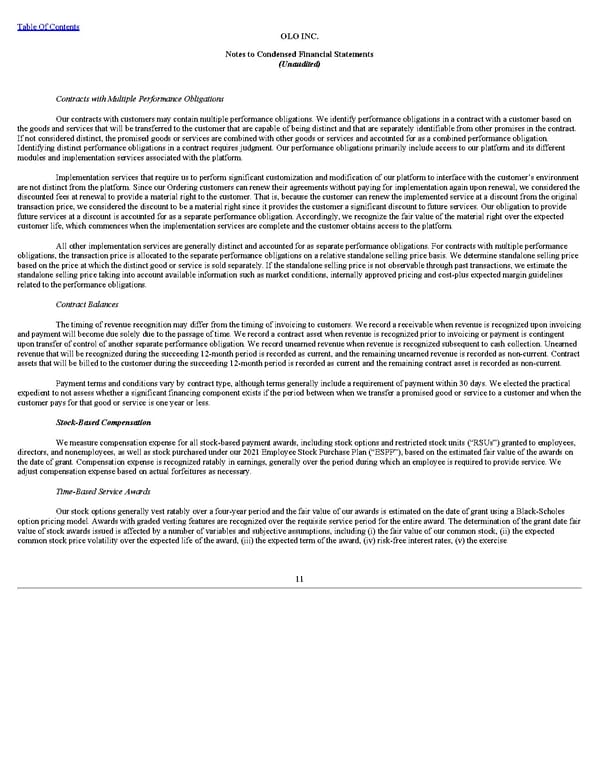Table Of Contents OLO INC. Notes to Condensed Financial Statements (Unaudited) Contracts with Multiple Performance Obligations Our contracts with customers may contain multiple performance obligations. We identify performance obligations in a contract with a customer based on the goods and services that will be transferred to the customer that are capable of being distinct and that are separately identifiable from other promises in the contract. If not considered distinct, the promised goods or services are combined with other goods or services and accounted for as a combined performance obligation. Identifying distinct performance obligations in a contract requires judgment. Our performance obligations primarily include access to our platform and its different modules and implementation services associated with the platform. Implementation services that require us to perform significant customization and modification of our platform to interface with the customer’s environment are not distinct from the platform. Since our Ordering customers can renew their agreements without paying for implementation again upon renewal, we considered the discounted fees at renewal to provide a material right to the customer. That is, because the customer can renew the implemented service at a discount from the original transaction price, we considered the discount to be a material right since it provides the customer a significant discount to future services. Our obligation to provide future services at a discount is accounted for as a separate performance obligation. Accordingly, we recognize the fair value of the material right over the expected customer life, which commences when the implementation services are complete and the customer obtains access to the platform. All other implementation services are generally distinct and accounted for as separate performance obligations. For contracts with multiple performance obligations, the transaction price is allocated to the separate performance obligations on a relative standalone selling price basis. We determine standalone selling price based on the price at which the distinct good or service is sold separately. If the standalone selling price is not observable through past transactions, we estimate the standalone selling price taking into account available information such as market conditions, internally approved pricing and cost-plus expected margin guidelines related to the performance obligations. Contract Balances The timing of revenue recognition may differ from the timing of invoicing to customers. We record a receivable when revenue is recognized upon invoicing and payment will become due solely due to the passage of time. We record a contract asset when revenue is recognized prior to invoicing or payment is contingent upon transfer of control of another separate performance obligation. We record unearned revenue when revenue is recognized subsequent to cash collection. Unearned revenue that will be recognized during the succeeding 12-month period is recorded as current, and the remaining unearned revenue is recorded as non-current. Contract assets that will be billed to the customer during the succeeding 12-month period is recorded as current and the remaining contract asset is recorded as non-current. Payment terms and conditions vary by contract type, although terms generally include a requirement of payment within 30 days. We elected the practical expedient to not assess whether a significant financing component exists if the period between when we transfer a promised good or service to a customer and when the customer pays for that good or service is one year or less. Stock-Based Compensation We measure compensation expense for all stock-based payment awards, including stock options and restricted stock units (“RSUs”) granted to employees, directors, and nonemployees, as well as stock purchased under our 2021 Employee Stock Purchase Plan (“ESPP”), based on the estimated fair value of the awards on the date of grant. Compensation expense is recognized ratably in earnings, generally over the period during which an employee is required to provide service. We adjust compensation expense based on actual forfeitures as necessary. Time-Based Service Awards Our stock options generally vest ratably over a four-year period and the fair value of our awards is estimated on the date of grant using a Black-Scholes option pricing model. Awards with graded vesting features are recognized over the requisite service period for the entire award. The determination of the grant date fair value of stock awards issued is affected by a number of variables and subjective assumptions, including (i) the fair value of our common stock, (ii) the expected common stock price volatility over the expected life of the award, (iii) the expected term of the award, (iv) risk-free interest rates, (v) the exercise 11
 Q3 2021 10Q Page 16 Page 18
Q3 2021 10Q Page 16 Page 18